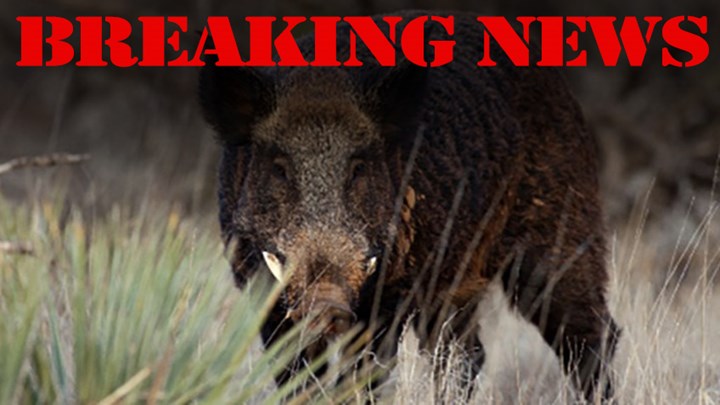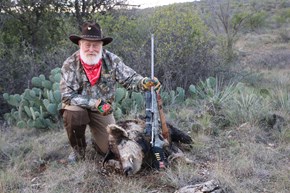
by Larry L. Weishuhn, wildlife biologist and outdoor TV host - Thursday, February 23, 2017

A battle is and has been raging in Texas over feral hogs. There are citizens that love them, who hunt and utilize their meat for food, and, those who see them as destructive vermin, “unwanted aliens” that destroy crops, landscapes and other wildlife.
Currently there are an estimated 2,500,000 feral or wild hogs in Texas. Those involved in traditional agriculture further estimate that feral swine cause about $52,000,000 annually in damage in the Lone Star state and $1.5 billion across North America. Efforts aimed at controlling feral hog numbers have included day and night hunting with and without dogs; using night vision, heat-detecting optics and baiting; trapping; and shooting them from helicopters both by state agencies and private citizens. Yet in the face of all these control efforts, wild hogs continue to increase their numbers and expand their range.
However, while seen as vermin by some, feral hogs also provide many hours of recreation for those who pursue them. They also provide considerable income to rural communities (several towns have established community events around the wild hog “culture” such as the long-standing “Cotulla Wild Hog Cook-Off” and “Sabinal Wild Hog Festival”); to landowners who receive trespass fees from hog hunters; and to sporting goods dealers in terms of specialized equipment used for hunting wild hogs. Feral hogs also provide what many describe as better and healthier meat than produced by commercial pork producers.
Love or hate wild hogs, on Feb. 21, 2017, Texas Agriculture Commissioner Sid Miller approved the use of “Kaput Feral Hog Lure,” a pesticide, warfarin-based bait, by state-licensed pesticide applicators only, and only on feral or wild hogs. Warfarin is an anticoagulant that prevents blood from clotting. Continued ingesting of it causes internal bleeding resulting in death. In swine, death usually occurs within three to four days of ingestion.
This drug has long been used as a key ingredient of pesticides for rats and mice. It too is used in human medicines to help “thin” blood.
“Kaput,” properly administered, will be placed in specially designed feeders that hogs have been conditioned to use. These feeders will have a heavy lid (16 pounds) which, in theory, can only be accessed by feral hogs to hopefully prevent other wildlife from consuming the warfarin-laced feed.
Texas’ Agriculture Commissioner is credited with saying “Kaput”, produced by Scimetrics, Ltd. Corp., has been tested extensively in partnership with several state agencies including the Texas Department of Agriculture. Texas AgriLife Extension Service has also approved the use of warfarin. Texas Parks and Wildlife Department stated its support of the new wild-hog management program using “Kaput.”
In a prepared report, Ag Commissioner Miller stated feral hogs are susceptible to fairly low levels of warfarin toxicity where humans and other animals require much higher levels of exposure to reach toxicity effects. According to the manufacturer, a dye incorporated in “Kaput” stains the fatty tissue of hogs that have consumed the warfarin-laced bait a bluish color.
Miller’s statement reads, “Warfarin at 0.005 percent (which is the level stated on the “Kaput” label) as a feral hog toxicant has been shown to have a lower level of residue in hog meat, especially in muscle tissue, which is what humans typically consume. One person would have to eat 2.2 pounds of hog liver, where the warfarin is concentrated in the body, to achieve the same exposure as a human would receive in one therapeutic dose of warfarin.” The statement further states, “In general, secondary exposure to other animals is low because warfarin in targeted animals (hogs) is generally too low to be toxic to either predator or scavenger.” The statement continues to say, “Warfarin has been studied extensively in animals and is practically non-toxic to birds. Due to the insolubility of warfarin in water, there should be no impact on aquatic life. Non-target wildlife, livestock and domestic pets would have to ingest extremely large quantities over the course of several days to reach a toxic level of warfarin in the bloodstream.”
Several groups including the Texas Hog Hunters Association have stated their opposition to poisoning wild hogs. Other groups are questioning what effect warfarin-laced bait, if not properly administered, might have on other species such as javelina.
What effect will this move have toward what Texas Ag Commissioner Miller is calling a “Hog Apocalypse” on hunting wild hogs in Texas? It must be remembered Texas lands are essentially 95 percent-plus privately owned. Each landowner can and must decide whether or not to use the services of a state-approved pesticide applicator to set up specialized hog feeders using “Kaput” to try and eradicate the wild hogs on his or her property. Access to such property only can be gained through the landowner’s permission. These bait areas will be checked on a regular basis for carcasses, which will be required to be properly “taken care of,” meaning buried or burned, to minimize the ingesting of warfarin-tainted meat by other species. It also has been suggested by some that, as a precautionary measure, no livestock be allowed to graze for 90 days on the property where Kaput has been used.
Will Kaput truly cause a hog apocalypse in Texas? Only if all Texas property owners enroll in the program. Remember there are landowners who love wild hogs and those who hate them. Quite often those from the two camps are across-the-fence neighbors. As a professional wildlife biologist who has worked with landowners and hunters throughout Texas for nearly 50 years, I have my doubts wild hogs are facing an apocalypse! Wild or feral hogs have been in Texas since they were introduced by early Spanish explorers in the 1500s, and I suspect they will be here for many more years to come!
■ ■ ■
About the Author
Legendary “Mr. Whitetail,” Larry Weishuhn, host and owner of DSC's "Trailing the Hunter's Moon," is one of the most popular and widely-recognized wildlife biologists and outdoor media personalities nationwide. Over the past five decades, he has authored multiple books and numerous articles on hunting and wildlife conservation. In his 2004 book, Trailing the Hunter's Moon, was named Foreword Magazine's Gold Book of the Year in the Adventure and Recreation category.
Over the past five decades, he has authored multiple books and numerous articles on hunting and wildlife conservation. In his 2004 book, Trailing the Hunter's Moon, was named Foreword Magazine's Gold Book of the Year in the Adventure and Recreation category.
A lifelong hunter, Weishuhn has long served as a featured speaker for the NRA and other organizations including Dallas Safari Club (DSC) and the Texas Wildlife Association (TWA), where he was one of three co-founders promoting science-based wildlife management, firearms and hunting. For more information, click here.
E-mail your comments/questions about this site to:
[email protected]
